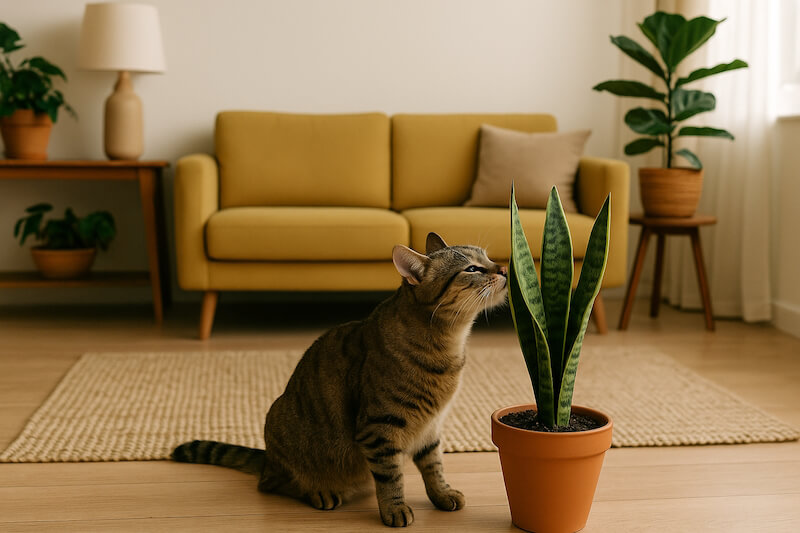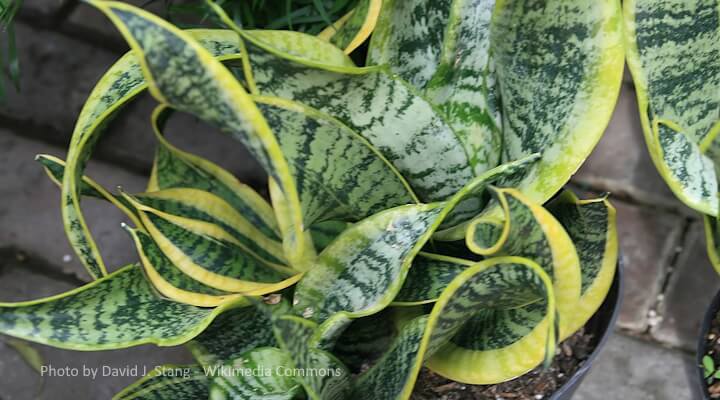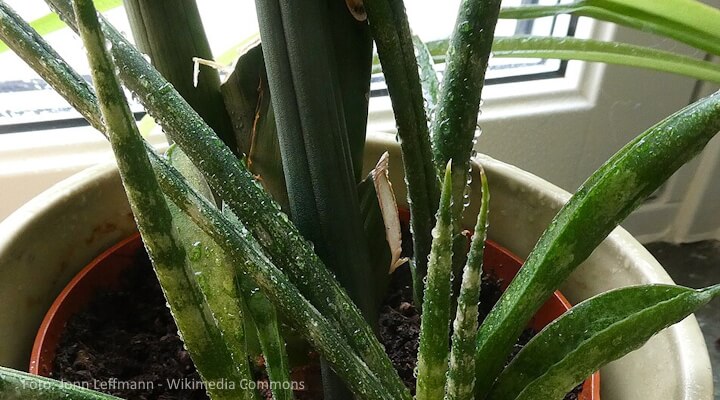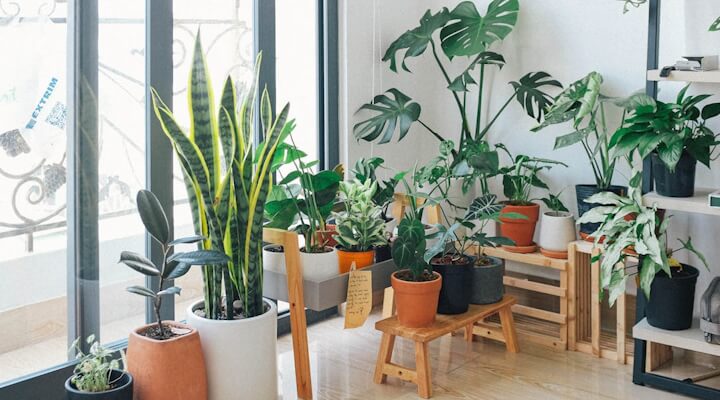
Are Snake Plants Toxic to Cats? What Pet Owners Should Know

Yes, snake plants are toxic to cats. The leaves of Sansevieria contain saponins, natural chemicals that irritate the digestive system. If chewed, they can cause vomiting, drooling, and stomach pain. Most cases are mild, but knowing the symptoms and when to call a vet is key to keeping your cat safe.
Are you worried about what happens if your pet cat chews on snake plant leaves? Maybe you’ve noticed bite marks on that striking, sword-shaped leaf. A trail of kitty drool. Or maybe you love the beauty of snake plants and are wondering if it’s safe to bring one home to your feline friend.
Quick Navigation
- Why Are Snake Plants Toxic to Cats?
- What Happens If a Cat Eats a Snake Plant?
- Are All Varieties of Snake Plants Toxic to Cats?
- Symptoms of Snake Plant Poisoning in Cats
- Can Snake Plants and Cats Coexist?
- Cat-Friendly Plants: Alternatives to Snake Plants to Enhance Indoor Aesthetics
- How to Keep Cats Away from Snake Plants
- Styling Tips: How to Use Snake Plants Safely in Pet Homes
- Styling Tips: How to Use Snake Plants Safely in Pet Homes
Here’s the deal: There are many benefits of snake plants, and many have stunning sword-like leaves, but they contain a toxic compound called saponin. Even a small bite can cause vomiting, oral irritation, or loss of appetite. While rarely life-threatening, the symptoms of snake plant toxicity in cats are enough to stress out any pet owner.
The good news? You don’t have to choose between a lush indoor garden and your cat’s safety. From spotting symptoms to safe alternatives like Spider Plants and Parlor Palms, here’s everything you need to know to protect your curious companion—and still enjoy your favorite house plants.
Are Snake Plants Cat Safe?
They may look good, but snake plants are toxic to cats. The plant’s saponins can trigger unpleasant reactions if your cat takes a bite. It’s rarely serious, but it’s definitely not ideal. If you’ve got a curious kitty, skip the stress and swap it out for a safe, stylish plant instead.
Want prevention, not panic? See our other article on the site on ways to keep pets away from snake plants. You’ll also discover pet-safe deterrents, barriers, and safe alternatives that stop nibbling before it starts.
Toxicity is just one piece of the puzzle. For the full rundown on soil, watering, and long-term care, see my complete snake plant care guide.
Is a Snake Plant Poisonous to Cats?
Snake plants are poisonous to cats because they contain saponins—a natural compound that irritates the digestive system. Saponins trigger vomiting, drooling, diarrhea, and lethargy in cats and dogs. Call your vet if symptoms appear. Give water. Don’t induce vomiting unless a vet says so.
So what exactly is the poisonous compound saponin? Think of them as the plant’s security system. They’re chemical compounds that mess with the cell membranes of fungi, insects, and, unfortunately, your cat’s gut lining. According to the ASPCA, they’re the reason Snake Plant ingestion can cause vomiting, drooling, and other not-so-fun side effects.

And no, it’s not just one variety. Whether it’s that chic Moonshine or the classic Mother-in-Law’s Tongue, every part of the plant contains this toxic substance. It’s the trade-off for all that sculptural beauty and beginner-proof charm.
Bottom line? This popular houseplant may look great in your living room, but it’s not a friend to your feline. Curious cats and saponins just don’t mix.
Do you have other houseplants that could be toxic to cats? If so, discover several ways to keep cats away from plants, including DIY cat deterrent spray and other natural methods.
Symptoms of Snake Plant Poisoning in Cats
Symptoms that your furry friend has nibbled on a snake plant leaf or licked it usually appear within hours. First symptoms of ingesting toxic plants include vomiting, drooling, and, suddenly, your pet cat is skipping meals.
Here are common symptoms cat owners report:
- Sudden drooling (like, puddles)
- Gagging or pawing at the face
- A “no thanks” to food
- Diarrhea or messy litterbox trips
- Big, dilated pupils
- Hiding, acting off, or just zoning out
Thankfully, most cases cause mild reactions, but still enough to set off your internal alarm bells. Good news? Not a crisis, but definitely enough to raise eyebrows and put your feline friend under observation for 24 hours.
Here’s what the first 24 hours might look like:
- Hour 0–2: Licking lips, foamy drool, a look of “ugh”
- Hour 2–6: Vomiting, avoiding food, low-key hiding in weird places
- Hour 6–12: More chill, possibly tired or just annoyed
- Hour 12–24: Symptoms fade—or it’s vet time if they don’t
One cat parent said on Reddit, “Our Maine Coon chomped a bit and threw up on the rug—classic. But she bounced back like nothing happened.”
Wondering what happens if your cat just licks a snake plant? Our full guide explains the symptoms and steps to take.
When should you call a vet if symptoms of snake plant poisoning persist? If the vomiting doesn’t stop, your cat looks uncomfortable, or if anything just feels off. Trust your gut—and don’t Google yourself into panic mode. Your furry friend deserves professional eyes if anything lasts longer than a day.

Chewing can damage leaves, but yellowing often has other causes. Learn more in my guide on snake plant leaves turning yellow.
Are All Varieties of Snake Plants Toxic to Cats?
Yes—all types of snake plants are toxic to cats. Doesn’t matter if it’s short and curly, tall and sculptural, or Insta-famous. If it’s a snake plant, it packs saponins—and those don’t sit well with feline guts.
It’s easy to assume some types are safer than others, especially the pretty ones with silvery leaves or trendy names. But here’s the deal: the entire plant contains the same toxic compound, no matter the shape or size.
Common culprits include:
- Moonshine Snake Plant – dreamy, but still contains toxic components
- Laurentii – the classic yellow-striped variety
- Cylindrica – those sleek, spear-like stalks
- Bantel’s Sensation – white variegation, same risk
- Dracaena angolensis – yes, the name’s different; it’s still a toxic plant
So if you’re a cat owner with a love for minimalist green décor, that’s your cue to pause. Even the most elegant snake plants can leave your cat with an upset stomach and you with a whole lot of worry.
If your pet has nibbled the leaves and they’ve started to sag, my guide on why snake plants droop covers both damage and recovery.
Can Snake Plants and Cats Coexist?
Snake plants and cats can coexist—but only if the plant is 100% out of reach. Sounds simple. It isn’t always.
You might get away with it if your cat ignores plants or your Snake lives in a no-cat zone (think: floating shelf, closed cabinet, or sealed terrarium). But let’s be honest—cats love to climb, chew, and investigate anything that moves. And those tall, fluttery leaves? Basically, an invitation for your cats to nibble.
Bu if you’d rather rely on deterrents, see my full guide on how to keep cats away from snake plants.
Cat-Friendly Plants: Alternatives to Snake Plants to Enhance Indoor Aesthetics
There are plenty of gorgeous, non-toxic options that love indirect light and won’t bother your curious creature.
Cat-friendly plants to try instead:
- Spider Plant – dangly, fast-growing, and totally safe
- Areca Palm – tropical vibes without the worry
- Parlor Palm – a common houseplant that’s elegant and low-maintenance
- Prayer Plant – colorful leaves that fold at night and a colorful houseplant totally safe for cats
- Cast Iron Plant – basically unkillable, and pet-safe
- Polka Dot Plant – tiny pops of color for shelves or desks
- Ponytail Palm – quirky and fun (it’s not a real palm)
- Butterfly Palm (aka Bamboo Palm) – lush, airy, and safe
- African Violets – great for bright spots and blooms year-round
- Nerve Plant – loves humidity, pet-safe, and Insta-cute
- Chinese Money Plant – round leaves, zero drama
- Shamrock Plant – a charming, clover-like option with flair
Truth is, a plant you don’t have to worry about? That’s worth its weight in peace of mind. For more ideas on cat-safe alternatives, check out our articles on the best purple houseplants, including the purple passion plant which is on the list of non-toxic pet plants.
Beyond their striking leaves, snake plants can surprise you with blooms. Here’s how to spot and care for snake plant flowers indoors so you don’t miss this rare event.
Snake Plant Poisonous to Cats? How to Keep Cats Away from Snake Plants
Want to keep your cat away from your snake plant? You’ll need height, strategy, and a little cat psychology. These snake plants are toxic to cats—so keeping paws off is non-negotiable.

Start with the obvious: get it up. Cats can jump, but most won’t bother with a plant that’s awkward to access or too dull to reach. Make the path annoying. Make it weird. Think like a cat.
Want to get some more cat-tested tricks to protect your plant, your furry friend, and your peace of mind? Check out my complete guide on how to keep cats away from snake plants.
And remember, no setup is perfect. If your cat’s obsessed and persistent? It might be safer (and less stressful) to swap the snake for a plant that doesn’t come with a warning label.
Worried about more than toxicity? Curling, clawing, or drooping leaves are all signs of stress. Learn the common reasons why plant leaves are curling and how to bring them back to health.
Styling Snake Plants Safely in Pet-Friendly Homes
Yes, you can keep a snake plant in a pet-friendly home—if you style smart. It’s all about where you put it, how you frame it, and whether your cat can turn it into a jungle gym.

The trick? Make it a visual statement, not a feline invitation.
Here’s how to style it like a pro and keep your cat out of the ER:
- Go vertical. Think plant shelves with no furniture nearby to jump from. Bonus points if they float.
- Use a glass cabinet. The IKEA Milsbo is basically the plant parent’s secret weapon.
- Layer with distractions. Add cat-safe plants nearby (Spider Plant, Prayer Plant) to redirect attention.
- Create texture barriers. Pinecones, citrus peels, or even a chunky rock mulch can work.
- Tuck it in a corner. Tight spaces make it harder to sneak in unnoticed.
- Hang it like art. Basket planters from the ceiling = high style, zero access.
Snake Plants look great—but they’re not worth the stress if your cat’s on a mission. So style with intention, and keep your indoor jungle as safe as it is stunning.
FAQ: Snake Plants and Cat Safety
Are snake plants safe for kittens?
No—snake plants are toxic to kittens just like adult cats. In fact, young kittens may be more vulnerable due to their size and sensitive systems. Even a small nibble can cause gastrointestinal upset, drooling, or lethargy. Keep snake plants completely out of reach or avoid them entirely in homes with kittens.What part of the snake plant is most toxic?
Every part of the snake plant is toxic to cats. The saponins are present in the leaves, stems, and even the roots. While the fleshy leaves are most often chewed, the entire plant contains this toxic compound. Any ingestion—no matter which part—can trigger a reaction in sensitive cats.Should I call the vet if my cat licked a snake plant?
Yes, if you notice symptoms of poisoning and then persist over 12 hours. Snake plants contain saponins that irritate a cat’s stomach. Even a quick lick can trigger drooling, nausea, or vomiting. A vet will tell you whether to monitor at home or bring your cat in for treatment. Always call rather than wait—it’s the safest move.How much does a cat need to eat to get sick?
It doesn’t take much. A few bites can cause mild to moderate symptoms in most cats. Smaller cats or those with underlying health issues may react to even less. While it rarely leads to severe illness, it’s best to contact your vet if any plant material was consumed.Can snake plants cause skin irritation in cats?
It’s uncommon, but possible. Most reactions happen when the plant is chewed or swallowed. That said, the sap can cause mild skin irritation in rare cases—especially around the mouth or paws. If your cat starts scratching, drooling, or showing discomfort after contact, wash the area and monitor closely.Are snake plants toxic to dogs too?
Yes. According to the ASPCA, snake plants are also toxic to dogs. They contain the same saponins that can irritate the digestive tract and cause symptoms like vomiting, diarrhea, or drooling. Keep snake plants out of reach from all furry friends—not just cats.Do Snake Plant Flowers Pose a Risk to Cats?
Snake plant flowers are rare, but when they do bloom, they’re just as toxic as the leaves. The blossoms contain the same saponins that can upset your cat’s stomach if chewed. While most cats ignore the flowers, it’s safest to keep blooming snake plants out of reach or choose a non-toxic alternative.Is Sansevieria Moonshine toxic to cats?
Yes. Sansevieria Moonshine, like all snake plant varieties, contains saponins and is toxic to cats. Despite its soft, silvery appearance, it carries the same risk as other types. If your cat is prone to chewing plants, it’s best to avoid Moonshine and opt for pet-safe alternatives.What should I do if my cat eats a snake plant?
Remove the plant, check how much was eaten, and monitor your cat for symptoms like vomiting, drooling, or lethargy. Don’t induce vomiting unless a vet tells you to. Call your vet or the ASPCA Animal Poison Control Center for advice—especially if your cat is very young or acting off.My Thoughts: Balancing Pet Safety and Plant Love
You don’t have to give up your love of plants to keep your cat safe—you just have to get intentional. Snake Plants may not be the best fit for curious homes, but that doesn’t mean your green dreams are over.
With a little strategy and a shift in mindset, you can design a space that feeds your need for calm, color, and life without risking your furry companion’s health. Whether you decide to elevate, enclose, or swap for a cat-safe stunner, the goal stays the same: create a home that feels good—for every living thing in it.
Because a beautiful space isn’t just about what’s in it. It’s about who it’s safe for.
